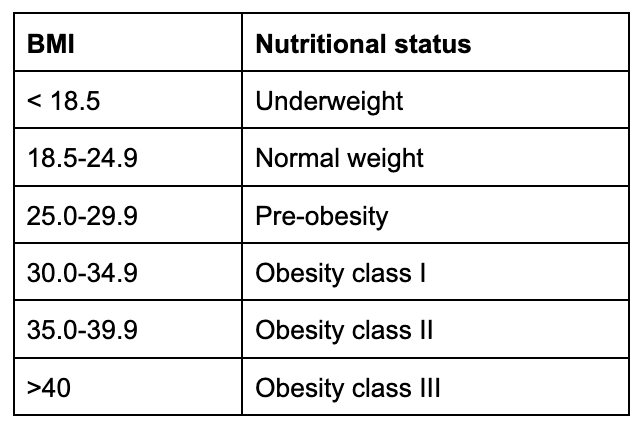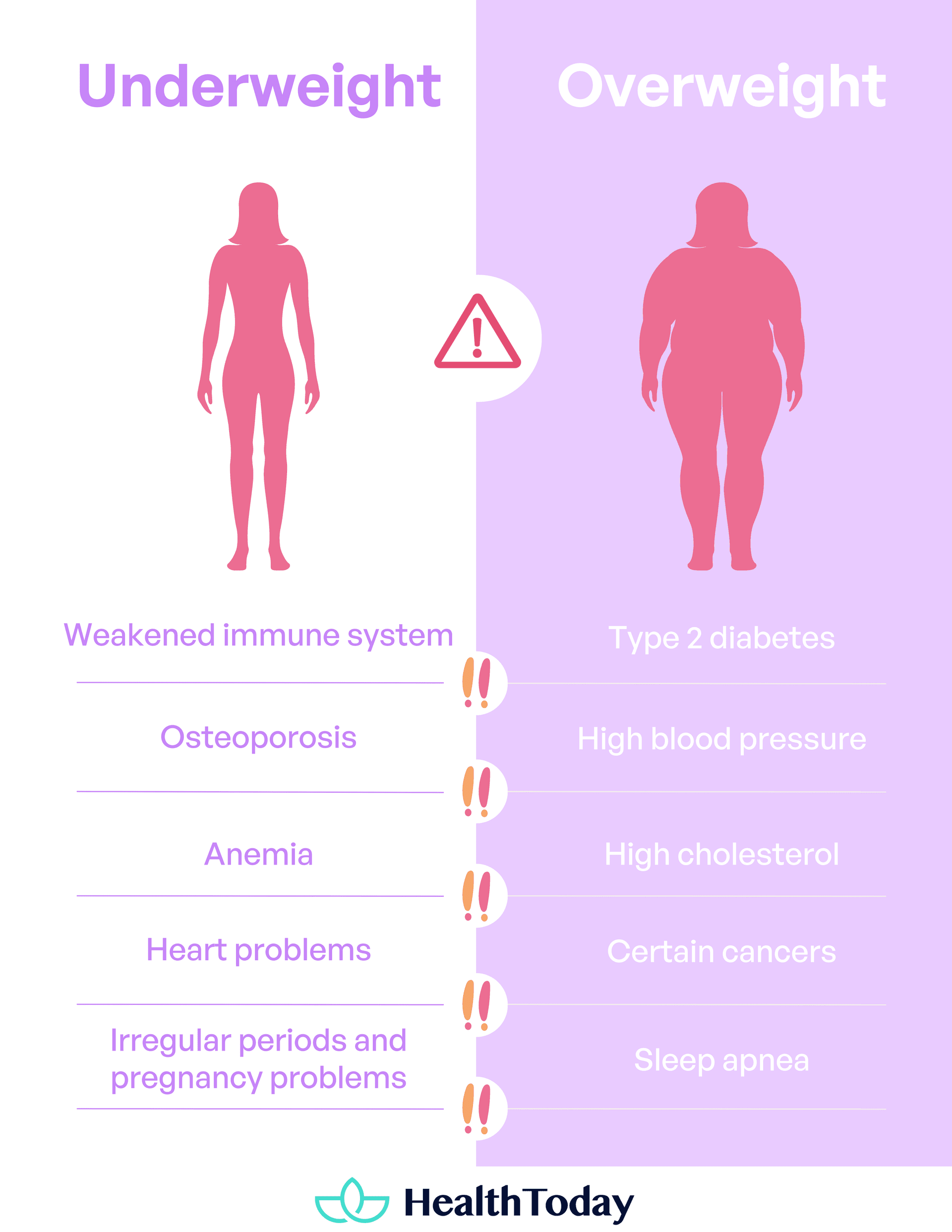Table of Contents
You probably know how much you weigh. Perhaps you weigh yourself every day! But how much should you weigh? The answer is not so straightforward since there are a number of factors involved. Maintaining a proper weight is important since being either underweight or overweight can lead to serious health concerns.
Let’s find out how to calculate an ideal healthy weight and ways to identify excess body fat.
The origin of ideal body weight (IBW)
The concept of ideal body weight (IBW) was first introduced to estimate safe dosages for medicines in the late 1800s (1). Now it can refer to the healthiest weight with the lowest risk of diseases based on age, gender, height, and body composition.
Read on to discover the tools that can help you determine your ideal body weight!
A simple ideal body weight calculator
Over the years, several formulas have been developed to calculate your IBW. All formulas use a similar format: a separate benchmark figure for men and women set to weight and height for persons over 5 feet (152.4 cm) and increments for every inch over that height.
Different formulas have slightly different IBW numbers. The Devine formula is the more popular one and was originally designed for the dosing medication (2).
Body mass index and other weight factors
IBW formulas are not perfect. They only factored in age, gender, and height and were created primarily for calculating medicine dosages.
For a more accurate ideal body weight, we need to consider four additional factors, namely:
undefinedundefinedundefinedundefined
How to calculate Body Mass Index (BMI)
BMI stands for Body Mass Index. It is a calculated numerical value based on a person’s weight and height.
Here’s how to calculate BMI:
- Divide your weight (kg) by your height squared(m²)
- Round to one decimal place.
- The resulting number is your BMI.
If your height is 1.75 meters, you simply multiply this number by itself (height m²). If you weigh 76 kg, then the answer is (76 ÷ 3.06 = 24.8).
Alternatively, you can simply use an online BMI tool.
BMI is a useful weight management or screening tool and gives a general indication of whether or not someone may have a normal BMI, a high BMI, or perhaps a low body mass index.
The World Health Organization (WHO) has a useful normal BMI weight chart with additional classifications to know whether you need to lose weight or not (3):

It’s important to note that BMI is not a perfect measure of overall health, as it only counts height and weight. It doesn’t take into account age, gender, and muscle mass.
Body Mass Index BMI is a weight-to-height calculation to know your ideal body mass. It can help determine if you are at a healthy weight, but it doesn’t consider age, gender, and muscle mass. The WHO provides BMI weight chart for underweight, normal weight, and weight loss categories such as pre-obesity and obesity class I to III.
Body mass index and other weight factors
Waist circumference
When you measure your waist circumference, you are measuring the widest point of the waist. It is usually at the level of the belly button. Waist measurement provides information about your abdominal fat.
Here is the correct way to measure your waist circumference (4):
- Stand upright and place a tape measure around your midsection, which is just above your hip bones.
- Make sure the tape is level with your natural waistline.
- Keep the tape snugly to your waist but not too tight to compress your skin.
- Take a deep breath and read the measurement on the tape.
From this simple measurement, you can get a basic indication of your possible obesity status according to these baseline numbers:
- Men: 40 inches or more
- Non-pregnant women: 35 inches or more
Having a number higher than 40 inches for men and 35 inches for women means that you are more likely to have obesity-related health problems such as Type 2 diabetes and heart conditions.
Waist-hip ratio (WHR)
Waist-hip ratio (WHR) is another measurement to assess your body weight status and any possible health risk.
This ratio is calculated by dividing your waist circumference by your hip circumference.
To measure your hip circumference, encircle the widest hip region with the tape measure—it’s usual level to your hip bones.
Higher WHR indicates more fat around the waist, and there is a baseline for both men and women:
- Men: 0.90 and higher
- Non-pregnant women: 0.85 and higher
According to WHO, if your value is equal to or exceeds the baseline, you are at an increased risk for health problems linked to obesity (5).
Body fat percentage
The percentage of fat in your body that contributes to your total weight is your body fat percentage. It indicates how much of your body is composed of fat tissue.
Although BMI is the common tool for ideal body weight, a person with a proper BMI may have a very high body fat percentage.
The key baselines for body fat percentage are:
- Men: 10‒20%
- Women: 18‒28%
There are actually five different ways to calculate this percentage, some of them are more practical than others:
1. Body fat scales:
After you step on the scale, a weak electrical current travels through your body. Fat creates resistance which increases the value. Body mass scales are quite popular and easy to buy. However, they are not very accurate (6).
2. Skinfold measurement:
This is a simple though accurate method using a caliper—or a two-jawed measuring tool. It measures the thickness of skinfolds at different locations on the body. Then, you calculate the total body fat percentage using a formula or table.
The accuracy depends on the skill of the person taking the measurements. It’s best, therefore, to do it with a professional such as a personal trainer.
3. Bod pod (air displacement plethysmography)
The Bod Pod, or air displacement plethysmography, uses air displacement technology to measure your total body fat, mass, and volume. Basically, you sit in a special Bod Pod cabin for a few minutes in a swimsuit.
This method is quick, safe, and accurate. Some universities offer the Bod Pod test service, but it’s expensive.
4. Dual-energy X-ray absorptiometry (DXA)
Dual-energy X-ray absorptiometry (DXA) uses X-rays to measure bone density, fat tissue, and muscle mass. You simply lie down to be scanned.
It’s very accurate; however, it’s costly and requires specialized equipment in a hospital or medical examination center (7).
5. Hydrostatic weighing
This method compares your normal weight to your weight in water. Fat is lighter than water, so this creates a weight difference which is used to calculate the fat percentage. It requires being submerged in water for 10 minutes (8).
The percentage of your body made up of fat tissue is your total body fat. There are five ways to measure your weight ratio or body fat percentage. These range from less accurate but more accessible methods, such as body fat scales, to highly accurate but expensive methods, like Dual-energy X-ray absorptiometry.
Factors that affect a healthy weight
Age
As you age, your body undergoes various changes that can affect weight and body composition.
When you get older, your ideal average weight may slightly decrease because you tend to lose muscle mass and bone density. However, aging also slows your metabolism, making you more likely to gain fat and weight.
Here are some recommended weight ranges for different age groups:
- Infants and Toddlers (0‒2 years old):
Weight can vary greatly during the first few years of life. It’s necessary to monitor growth patterns and see a pediatrician if you have any worries.
- Children (3‒12 years old):
According to the CDC, the average weights for children are as below:
- 3 to 4 years old: 31‒40 pounds (14‒18 kg)
- 5 to 8 years old: 41‒75 pounds (19‒34 kg)
- 9 to 12 years old: 70‒120 pounds (32‒54 kg)
- Adolescents (13‒17 years old):
For adolescents, an ideal average weight or teen BMI can vary widely based on height and body composition. CDC provides a BMI calculator to determine whether their weight falls within a healthy range (9).
- Adults (18+ years old):
For adults, a healthy weight range is typically determined by BMI. A BMI of 18.5 to 24.9 is considered an ideal average weight range for adults.
Gender
Generally, males have more muscle mass and less body fat than females. That’s why their body fat-to-muscle ratio differs even if the BMI number is the same.
Also, men tend to have a higher metabolic rate. This means all else being equal, men burn more calories at rest than women do. That is, men typically require more calories per day to maintain their weight and energy levels than women.
As a result, the ideal body weight for men and women can differ. Men typically have a higher ideal weight due to their higher muscle mass and metabolic rate.
Height
Height is one of the two factors that is taken into account when calculating body mass index (BMI). As already mentioned, BMI is calculated by weight (kg) divided by height in meters squared (m²).
Taller people tend to have longer limbs and larger overall body sizes. However, it’s not always the case that taller people have more muscle than shorter people. So, it’s inaccurate to think that taller people have a higher ideal body weight.
Muscle mass
Muscle mass is the amount of muscle tissue in the body. It is crucial for supporting the skeletal system, maintaining posture, and enabling movement. Also, it is an important component of overall body composition, along with fat, bone, and water.
People with higher muscle mass may have a higher ideal body weight.
It’s not that muscle weighs more than fat. A pound of muscle weighs exactly the same as a pound of fat—around 453.59 grams. It is because muscle is metabolically active tissue requiring more energy to maintain than fat.
Also, muscle tissue is denser than fat tissue, so for the same weight, muscle takes up less space in the body compared to fat. Two people with the same weight can look very different with different proportions of muscle mass and fat.
Health risks of being overweight

Being overweight is a well-understood health risk. This is why it is important to know your ideal weight and when you may be at greater risk, especially from disease control or chronic illness (10).
Type 2 diabetes
Type 2 diabetes is when your blood glucose (blood sugar) is too high because your body can not process it correctly. The body cells of overweight people may be less sensitive to insulin, the hormone that helps glucose enter the cell to be converted to energy. This prevents glucose from entering the cells, and the sugar remains in the blood, which can eventually lead to diabetes (11).
High blood pressure (hypertension)
Excess weight strains the heart and blood vessels, causing the blood pressure to rise. Meanwhile, too much weight can activate certain hormones that make the kidneys hold onto more salt and water, causing high blood pressure as well (12).
High cholesterol
Overweight individuals can have high cholesterol, specifically low-density lipoprotein (LDL) cholesterol— or the ‘bad’ cholesterol.
Being overweight increases the production of bad cholesterol by the liver. Furthermore, it decreases the ability to clear bad cholesterol from the blood.
Type 2 diabetes, high blood pressure, and high cholesterol are all risk factors for heart disease and stroke.
Certain cancers
Obesity can cause changes like inflammation in the body leading to any of the 13 types of cancer. Also, being overweight for longer periods of time increases the risk of getting cancer (13).
Sleep apnea
Being overweight can lead to airway obstruction during sleep, resulting in sleep apnea. A common symptom of apnea is snoring. Sleep apnea can cause daytime fatigue and other health problems.
Depression
Research has shown that individuals who are obese are at a greater risk of developing depression and vice versa (14). Overweight individuals may experience social isolation and discrimination, contributing to depression.
Alzheimer’s disease (AD)
Weight-related diseases are often quite complex and interrelated. Obesity can contribute to insulin resistance, inflammation, and oxidative stress. All of these can damage the brain and increase the chance of cognitive decline and AD (15).
In addition, obesity can lead to changes in certain hormones and proteins in the body, which also play a role in AD development. In fact, research shows that obesity in midlife may harm the brain and increase the risk of developing AD.
Joint problems
Excess weight puts additional pressure on joints, which can lead to joint problems like arthritis. Knees and hip joints are more susceptible to damage from excess weight because they support the body’s weight when standing and walking.
Disease-associated with being underweight
Not only being obese but also being underweight can contribute to chronic diseases.
However, it is important to note that the specific diseases associated with being underweight may differ from those associated with obesity.
Weakened immunity
Underweight individuals tend not to get enough nutrients to support a healthy immune system. These include protein and vitamins or minerals such as vitamin C, vitamin E, zinc, and selenium (16).
Osteoporosis
Osteoporosis is also related to the lack of proper nutrition, often as a result of being underweight (17). Calcium, vitamin D, and protein are necessary for your body to build and maintain strong bones. When the body doesn’t have enough of these nutrients, it weakens the bones leading to osteoporosis.
Anemia
This disease happens when your body has insufficient red blood cells to transport oxygen to different tissues and organs. If you don’t have enough nutrients (specifically iron) due to being underweight, you can develop anemia.
Irregular periods and pregnancy risks
Being underweight can cause a change in hormones in women. Estrogen is a hormone that regulates the menstrual cycle.
When a woman is underweight and doesn’t have enough fat to produce sufficient levels of estrogen, ovulation is interrupted, and menstruation stops.
Studies have shown that underweight women who are pregnant have a risk of PTB or preterm birth. (18)
Heart issues
Being underweight also has negative effects on the cardiovascular system. Lower levels of muscle mass, nutritional deficiencies, hormonal imbalances, and a weak immune system all contribute to heart disease (19).
How much should I weigh for my height?
The ideal weight-to-height ratio depends on your age, gender, and body composition. While BMI is a common indicator to estimate ideal weight, you can also consider waist circumference, waist-hip ratio (WHR), and body fat percentage.
Is BMI a reliable indicator of ideal average weight?
While BMI is commonly used, it may not be a reliable indicator of an ideal average weight for everyone. This is because BMI only accounts for height and weight but ignores age, gender, and muscle mass.
What is the most accurate way to measure body fat?
The most accurate ways to measure body fat are a Bod pod, a DXA machine, or hydrostatic weighing. These methods use expensive and specialized equipment, while a body fat scale or skinfold measurement is more practical but less accurate.
What factors affect the ideal healthy weight?
Factors that affect ideal weight include age, gender, height, and muscle mass. To determine your ideal weight, it’s best that you take all these factors into account.
What diseases are associated with obesity?
Obesity can cause chronic diseases such as type 2 diabetes, high blood pressure, and high cholesterol, all risk factors for heart disease and stroke. Also, being overweight increases the risk of cancer, sleep apnea, depression, Alzheimer’s, and joint problems.
Summary
‘How much should I weigh?’ is not a straightforward question to answer. However, knowing your ideal weight is important for overall health as well as disease control and prevention. Tools such as BMI and WHR are not the most accurate, but they provide a good range to aim for.
Factors like age, gender, and body mass all influence your ideal weight range. While determining your ideal weight is beneficial, it is also important to know from where the access weight could come.
Lastly, being healthy is not just about a number on the scale. So, be kind to yourself and live a lifestyle that supports your health and happiness.

















Comments
0